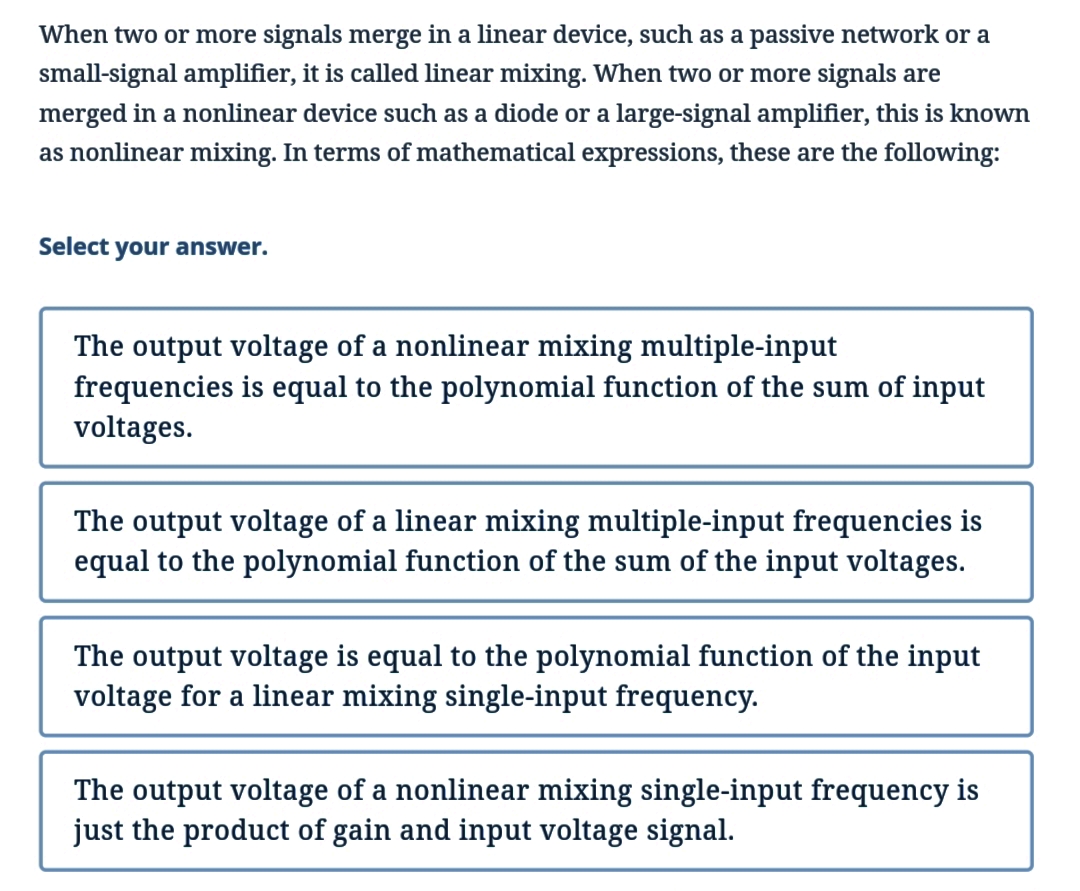When two or more signals merge in a linear device, such as a passive network or a small-signal amplifier, it is called linear mixing. When two or more signals are merged in a nonlinear device such as a diode or a large-signal amplifier, this is known as nonlinear mixing. In terms of mathematical expressions, these are the following:
When two or more signals merge in a linear device, such as a passive network or a small-signal amplifier, it is called linear mixing. When two or more signals are merged in a nonlinear device such as a diode or a large-signal amplifier, this is known as nonlinear mixing. In terms of mathematical expressions, these are the following:
Introductory Circuit Analysis (13th Edition)
13th Edition
ISBN:9780133923605
Author:Robert L. Boylestad
Publisher:Robert L. Boylestad
Chapter1: Introduction
Section: Chapter Questions
Problem 1P: Visit your local library (at school or home) and describe the extent to which it provides literature...
Related questions
Question

Transcribed Image Text:When two or more signals merge in a linear device, such as a passive network or a
small-signal amplifier, it is called linear mixing. When two or more signals are
merged in a nonlinear device such as a diode or a large-signal amplifier, this is known
as nonlinear mixing. In terms of mathematical expressions, these are the following:
Select your answer.
The output voltage of a nonlinear mixing multiple-input
frequencies is equal to the polynomial function of the sum of input
voltages.
The output voltage of a linear mixing multiple-input frequencies is
equal to the polynomial function of the sum of the input voltages.
The output voltage is equal to the polynomial function of the input
voltage for a linear mixing single-input frequency.
The output voltage of a nonlinear mixing single-input frequency is
just the product of gain and input voltage signal.
Expert Solution
This question has been solved!
Explore an expertly crafted, step-by-step solution for a thorough understanding of key concepts.
This is a popular solution!
Trending now
This is a popular solution!
Step by step
Solved in 3 steps with 2 images

Knowledge Booster
Learn more about
Need a deep-dive on the concept behind this application? Look no further. Learn more about this topic, electrical-engineering and related others by exploring similar questions and additional content below.Recommended textbooks for you

Introductory Circuit Analysis (13th Edition)
Electrical Engineering
ISBN:
9780133923605
Author:
Robert L. Boylestad
Publisher:
PEARSON

Delmar's Standard Textbook Of Electricity
Electrical Engineering
ISBN:
9781337900348
Author:
Stephen L. Herman
Publisher:
Cengage Learning

Programmable Logic Controllers
Electrical Engineering
ISBN:
9780073373843
Author:
Frank D. Petruzella
Publisher:
McGraw-Hill Education

Introductory Circuit Analysis (13th Edition)
Electrical Engineering
ISBN:
9780133923605
Author:
Robert L. Boylestad
Publisher:
PEARSON

Delmar's Standard Textbook Of Electricity
Electrical Engineering
ISBN:
9781337900348
Author:
Stephen L. Herman
Publisher:
Cengage Learning

Programmable Logic Controllers
Electrical Engineering
ISBN:
9780073373843
Author:
Frank D. Petruzella
Publisher:
McGraw-Hill Education

Fundamentals of Electric Circuits
Electrical Engineering
ISBN:
9780078028229
Author:
Charles K Alexander, Matthew Sadiku
Publisher:
McGraw-Hill Education

Electric Circuits. (11th Edition)
Electrical Engineering
ISBN:
9780134746968
Author:
James W. Nilsson, Susan Riedel
Publisher:
PEARSON

Engineering Electromagnetics
Electrical Engineering
ISBN:
9780078028151
Author:
Hayt, William H. (william Hart), Jr, BUCK, John A.
Publisher:
Mcgraw-hill Education,